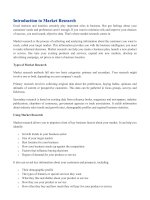Introduction to presentation skills
Bạn đang xem bản rút gọn của tài liệu. Xem và tải ngay bản đầy đủ của tài liệu tại đây (352.67 KB, 25 trang )
Short Introduction to
Presentation Skills
Erika Hawkes, Project Officer, University
Graduate School
Agenda
Preparation and Practice
Tone and Body Language
Perfect PowerPoint
Flipcharts and Whiteboards
Dealing with questions and interruptions
Facing your fears
Where to go next
What makes a good presentation?
Divide into groups
What makes a good presentation?
Some things to think about
- presenter
- resources
- structure
Feedback
Preparation
Preparation is key!
Key message
Audience
Time
Resources
Close
Structuring your Presentation
Three section structure:
introduction
information
recap.
Prepare everything you need in advance
Check on the day that everything works
Practice
Practice in front of people
In the venue
Fix things that don’t work
Timing
Gets you used to being in front of an
audience.
Giving the Presentation
Only a small proportion comes from what you
say
Posture.
Tone of voice.
Don’t rush!
Warm up!
Helps you to relax
Helps you to be heard
Helps you to sound more confident.
Warm up!
Deep breathing exercises- in for a count of 5,
out for a count of 5. In for 6, out for 6, and so
on, up to 10.
Hum! This loosens the vocal chords and
warms them up
Do some tongue twisters. Really try to
articulate the words. Get faster and faster!
Yawn.
Tongue Twisters!
Unique New York
She sells sea shells by the sea shore. The
shells that she sells are sea shells I’m sure
Red Lorry, Yellow Lorry
Peter Piper picked a peck of picked peppers
Rubber buggy baby bumpers
Giving the Presentation, cont:
Clothing: comfortable, appropriate
Maintain eye contact
Use notes if you need them
Think about when to use handouts
PowerPoint
Good Points
Portable
Professional
Can add graphics
Clear
Can use for
handouts
Bad points
Depends on
technology
Lack of audience
contact
Can’t add to it
Overcrowded
Facing your fears
Possible fears, and how to deal with them:
•Forgetting what to say: prepare and use notes or cue cards. If you do forget, take a deep breath, and don’t panic, as you’ll forget even more !
•Speaking in front of people: practice in front of a small audience first. Look just about the heads of the audience. Sometimes you will be nervous: accept it and
carry on
•Disruptions, people shouting out or being rude during your presentation: You control the presentation. If people are being noisy, disruptive, or rude, you have
the right to ask them to leave. If you’re unwilling to do this yourself, contact venue security if they are present.
•Getting lost: Allow plenty of time to get to the venue, take a contact number to call if you get lost, plan out the route beforehand, take a taxi if needed
•Questions: not knowing the answer to questions, people asking questions to trip you up: Prepare for common questions beforehand, if you can’t answer straight
away, take their details and get back to them
Public Speaking Tips
Breathe deeply
Take your time
Test the microphone
Smile!
PowerPoint tips
Look at the audience, not the slides
Don’t overcrowd
Pay attention to colour and layout
Print out slides
Test beforehand
Flipcharts and Whiteboards
Good Points
Low-tech
Easy to add to
More contact with
audience
More interactive
Bad Points
Can only use once
Can’t add graphics
Can be hard to read
Hard to see
Flipcharts and Whiteboard Tips
Don’t hide!
Draw lines if needed
Pay attention to colour
Call ahead to check on facilities
Stick to a few key points
Dealing with Questions
Questions show people are listening!
Allow time to deal with them
Decide when to answer them
Try and anticipate
Don’t be afraid to stop and think
What if I don’t know the answer?
Open it to the floor
Take details and answer later
Repeat the question back if you don’t
understand it
Facing your Fears
Write your fears on a post-it
Stick them up
Find ways to face them in the group
Any Questions?
Where next?
Presenting your research using PowerPoint
Poster Design: an introduction
Poster Design: Advanced
Poster Presentation: planning the content
Preparing for your Viva
Presentation Skills (2 Day course)
Confidence building workshop (Counselling and
Guidance)
Summary
Preparation is key!
Practice!
Watch out for tone and body language
Your flipchart/PowerPoint is a complement
only, don’t let it take over!
Questions are good, but prepare for them.
Fears can be tempered with good preparation
Get in touch
www.gradauteschool.bham.ac.uk
www.guildofstudents.com









